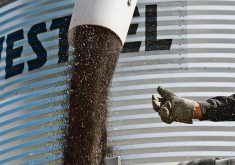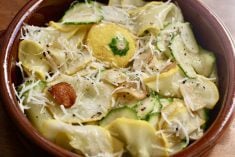Readers looking for Sunny Boy cereal may have to substitute Red River cereal. According to the Sask-atoon Co-op, Sunny Boy cereal is not available at this time because of a change of ownership. It will be restocked when available.
Breakfast, snack or dessert?
My sister-in-law, Sandra, gave me this granola bar recipe that I really like because I can vary the ingredients according to what’s on hand or our family’s taste.
Granola bars
1 cup melted butter 250 mL
or margarine
Read Also

Alberta cracks down on trucking industry
Alberta transportation industry receives numerous sanctions and suspensions after crackdown investigation resulting from numerous bridge strikes and concerned calls and letters from concerned citizens
2/3 cup corn syrup 150 mL
2 cups brown sugar 500 mL
2 cups flour 500 mL
4 cups oatmeal 1 L
(rolled oats)
1 teaspoon baking soda 5 mL
3 cups of a mixture of 750 mL raisins, coconut, almonds,
chocolate chips, sunflower seeds, or nuts of your
choice
Bake at 400 F (200 C) for 10 minutes. Do not overbake.
Gluten-free information
Last Saturday, I attended the 20th anniversary of the Saskatoon chapter of the Canadian Celiac Association.
I wandered into the vendor fair, which had a farmer’s market busyness with people mingling, chatting and carrying their bags of products out to their cars.
One woman described it as a wonderful opportunity to buy at ease with-out having to check all the labels carefully, since these vendor outlets were all selling gluten-free products.
Celiac disease, or CD, is an inherited disorder in which the absorptive surface of the small intestine is damaged by a substance called gluten, which results in the body being unable to absorb nutrients.
Gluten is the protein found in wheat, rye, triticale, barley and oats. The treatment for CD is a strict gluten-free diet for life.
It used to be that about one in 2,000 people were diagnosed with celiac disease. Shelley Case, writing in the Saskatchewan Pulse Growers PulsePoint magazine last month, said that for every person diagnosed, it is estimated 90 remain undiagnosed.
Dr. Thomas Sylwestrowicz, who spoke at this workshop, estimated that one in 200 Caucasian people of European descent and one in 150 of Irish descent are likely to have this disease.
If members of your immediate family have this disease, you have a 40-60 percent chance of developing it; with second degree relatives, only 10-20 percent chance.
It is mostly an adult disease, with only 12 percent diagnosed before the age of 10.
Symptoms are fatigue, abdominal pain, gas and bloating, anemia, diarrhea, depression and irritability, and muscle and skeletal aches and pains.
Lab clues are iron deficiency, low folates, anemia and bulky foul-smelling stools.
Undiagnosed celiac disease can have other more serious complications such as malnutrition, increased risk of osteoporosis, cancer, development of other autoimmune conditions such as thyroid disease, miscarriage, infertility in both women and men and neurological conditions and other health problems.
Misdiagnosis is common, with people told they have irritable bowel syndrome, fibromyalgia, chronic fat-igue syndrome or allergies.
A small intestinal biopsy and a blood test screening for celiac disease seem to be the most conclusive checks for CD.
Having this blood test before going on the gluten-free diet is recommended, as the diet will interfere with making the correct diagnosis.
The good and bad
People with CD find grains and breads are difficult to digest; rice is more friendly.
Initially, in addition to avoiding wheat, rye, barley and oats, it seems to work best to avoid milk and milk products.
A gluten-free diet allows rice, corn, buckwheat, potatoes, soy and tapioca. It means reading labels to ensure no gluten intake. Vitamin D, calcium and iron supplements are recommended.
PulsePoint magazine said the gluten-free market is a significant opportunity for value-added pulses. Pulses are a healthy option for people with CD. They are a source of dietary fibre, protein, iron and other minerals and vitamins.
Pulses are high in iron, and iron deficiency anemia is a common nutritional concern for celiacs, along with vitamin B deficiencies.
Pulses also help with constipation that arises as a result of a diet low in fibre.
The following recipe was in my conference bag so I tried it.
Gluten-free chocolate cookies
2 cups rice flour 500 mL
1/2 cup pure cocoa 125 mL
1/2 cup cornstarch 125 mL
pinch of cinnamon
1 cup butter, softened 500 mL
2/3 cup white sugar 150 mL
1 teaspoon vanilla 5 mL
Preheat oven to 325 F (160 C).
Whisk together first four ingredients.
Cream together butter and sugar until light and fluffy. Add vanilla extract.
Add dry ingredients in three stages to form a dough. Roll by tablespoon into one inch (2.5 cm) balls. Place two inches (five cm) apart on parchment-lined baking sheets.
Press cookies down with fork dipped in white sugar, flattening to 1/4 inch (0.5 cm) thickness.
Bake 18-20 minutes or until firm to the touch. Cool completely before storing in an airtight container.
Reader request
Dear TEAM: I am looking for a recipe for sweet pickled garlic that has only garlic and red peppers plus the brine solution. – E.S. Morinville, Alta.
Dear E.S.: This recipe is for sweet pickled onions, but the author suggested it could be used for pickled garlic as well.
I hope this is what you are looking for. You will need to add the red peppers.
Sweet pickled onions (or garlic)
5 pounds small white 2.5 kg
onions, should give you one gallon
1 cup pickling salt 250 mL
2 tablespoons white 30 mL
peppercorns
1 cup sugar 250 mL
5 cups white vinegar 1.25 L
1 bay leaf
3 tablespoons mustard 45 mL
seeds
Put the whole onions into boiling hot water for about two minutes. Then drain the boiling water and replace with cold water to stop the cooking process. Peel the onions. Sprinkle the onions (garlic) with the salt, add enough cold water to cover, and let stand overnight. I put mine in the fridge.
In the morning, drain the water from the onions, rinsing two or three times to clear out the salt. Put the sugar, vinegar, mustard seed and peppercorns in a large enamel kettle and bring to a boil. Simmer for at least 15 minutes. Pack the onions (garlic) into a clean gallon jar. Add one bay leaf and fill the jar with the boiling hot liquid and seal. Let it cool to room temperature and put in the fridge. They should be ready to use in about three weeks.
The process is really the same for sweet pickled garlic, except that I would break up the bulbs of garlic into cloves before boiling them.
Source: www.recipe.cottage.com/preserving/pickled onions.
Barbara Sanderson is a home economist from Rosetown, Sask., and one of four columnists comprising Team Resources. Send correspondence in care of this newspaper, Box 2500, Saskatoon, Sask., S7K 2C4 or contact them at team@producer.com.
















